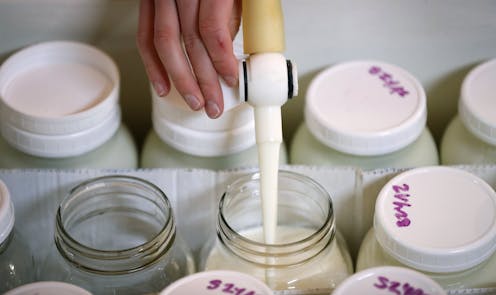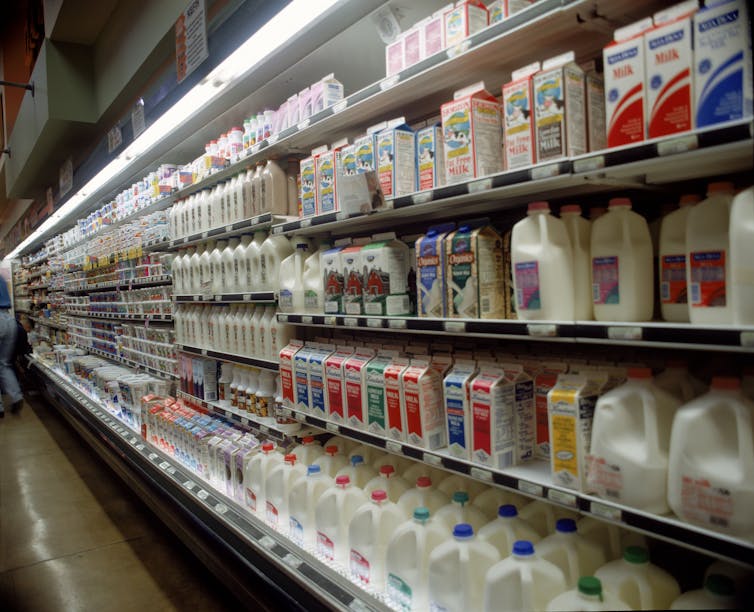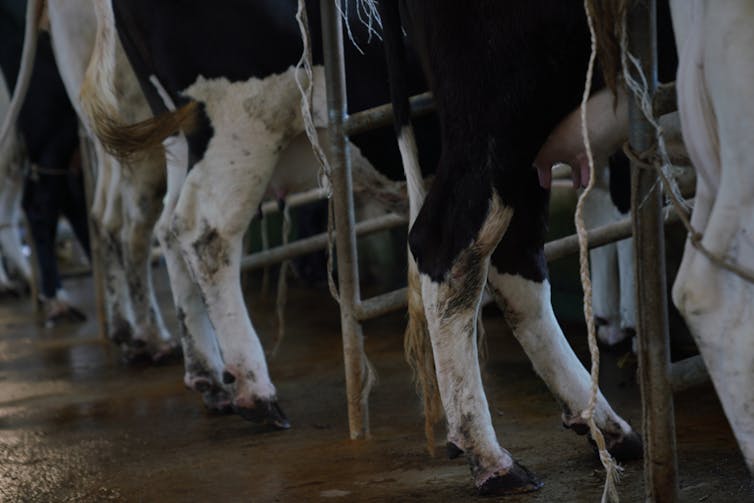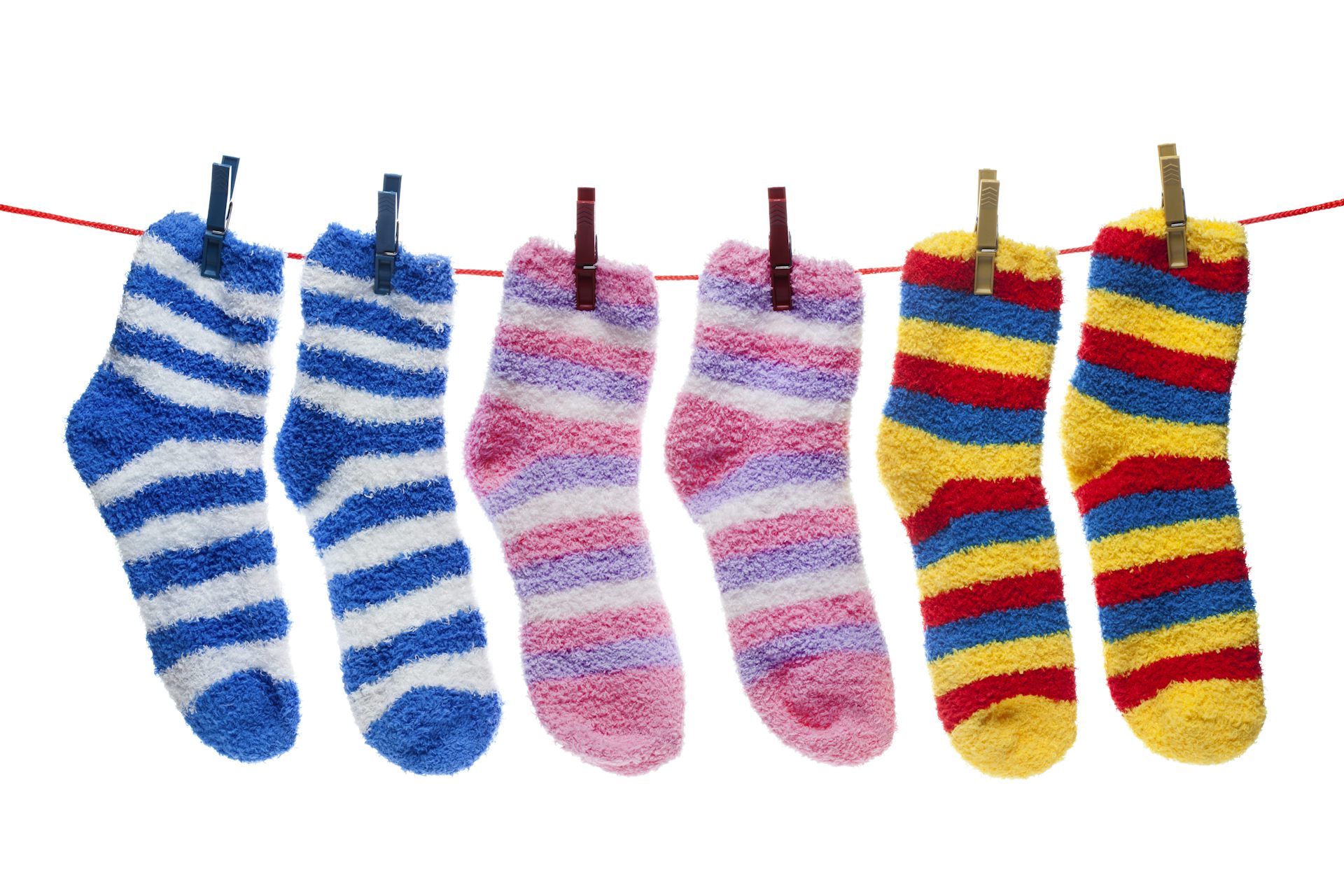Raw milk health risks significantly outweigh any potential benefits − food scientists and nutritioni
Raw milk has always carried the risk of serious illness, and this risk has only risen with bird flu spreading across dairy farms in the US.

Despite an ongoing outbreak of bird flu in dairy cows, the popularity of raw milk has only risen. Advocates claim raw milk has superior health benefits over pasteurized milk. There is little evidence to support these claims, however, and the risk of serious illness is much greater.
Mississippi State University food scientists Juan Silva and Joel Komakech and nutritionist Mandy Conrad explain the difference between pasteurized and raw milk, addressing common misconceptions about the health risks and purported benefits of consuming unpasteurized milk. These questions are more important than ever, since cattle can shed viral material into their milk. Not only can pathogens end up in milk, but at least three farmworkers reportedly have contracted H5N1, the virus that causes avian influenza, in 2024. Farmworkers can get sick by handling infected animals or their byproducts, such as raw milk.
What is pasteurization? Does it destroy nutrients?
Pasteurization is a process that involves heating beverages and foods at high temperatures – over 145 degrees Fahrenheit (62.78 degrees Celsius) – to kill harmful microorganisms, such as bacteria, viruses and parasites. This reduces the total number of microorganisms in the product and also inactivates enzymes that could contribute to spoilage.
The taste, nutritional value and quality of pasteurized products aren’t significantly affected by the process.
While pasteurization can lead to some nutrient losses, the changes are generally minimal and outweighed by the benefits. Pasteurization typically causes minor denaturation of proteins and has little effect on fats and carbohydrates. While water-soluble vitamins such as vitamin C and some B vitamins, usually not abundant in milk except vitamin B2, can be partially degraded during pasteurization, fat-soluble vitamins (A, D, E and K, found in significant amounts in milk) are more heat stable and suffer minimal loss.
Thus, nutritional losses in milk due to pasteurization are generally small compared with the significant benefits of reducing foodborne illnesses and spoilage.
Is raw milk healthier than pasteurized milk?
Studies have compared the benefits of raw milk with pasteurized milk and have found little evidence that raw milk is superior to pasteurized milk. The perceived advantages of raw milk are outweighed by its health risks.
First, raw milk does not improve lactose intolerance.
Raw milk also does not have more vitamins than pasteurized milk. Milk is not a good source of vitamin C or other heat-sensitive vitamins, and pasteurization does little to reduce vitamin B2 or riboflavin, which is not as sensitive to heat. Moreover, Vitamin D is added to pasteurized milk to enhance your body’s ability to absorb the calcium in milk.

Fortified milk replaces nutrients that may be lost in the pasteurization process. Vitamin D is added to milk to enhance uptake of the calcium found in the milk. No single food is perfect, so it is OK for milk to lack some nutrients, as these can be obtained from other foods.
Some people believe that probiotics – foods or supplements that contain live bacteria beneficial to health – are more prevalent in unpasteurized milk and products made from raw milk. However, raw milk is generally lacking in probiotics and has significantly more harmful bacteria. Probiotics are added to many dairy foods such as yogurt after pasteurization.
Furthermore, a 2011 review of the available research on the health benefits of raw milk found that many of these studies were conducted with poor methods, meaning their results should be interpreted with caution.
What are the health risks of consuming raw milk?
The health risks of consuming raw, unpasteurized milk come from the harmful microorganisms that may be present.
Raw milk has been associated with hundreds of foodborne disease outbreaks. Between 1998 and 2018, 202 outbreaks resulted in 2,645 illnesses and 228 hospitalizations. More recently, from 2022 to 2023, there were 18 outbreaks and recalls associated with raw milk. A number of outbreaks and recalls associated with pathogens in raw milk have already occurred in 2024. In all cases, pathogens in the raw milk that cause human diseases were directly responsible for these illnesses.

Some illnesses from the pathogens in raw milk can have serious long-term effects, including paralysis, kidney failure and death.
Researchers found that areas where raw milk was legally sold in the U.S. from 1998 to 2018 had over three times more outbreaks than areas where selling raw milk was illegal. Areas where raw milk was allowed to be sold in retail stores had nearly four times more outbreaks than areas where sales were allowed only on farms.
Is it safe to eat foods made from raw milk?
Many, if not all, dairy products made from unpasteurized milk are not safe to eat. A number of products can be made from raw milk, including soft cheeses, such as brie and Camembert; Mexican-style soft cheeses, such as queso fresco, panela, asadero and queso blanco; yogurt and puddings; and ice cream or frozen yogurt. Pathogens in raw milk can survive the processes involved in making these types of dairy products and thus be unsafe for consumption.
Only products that undergo a process to inhibit or kill harmful microorganisms may be safe enough to be made from unpasteurized milk. However, the potential for cross contamination of raw and cooked food as well as the survival of pathogens from inadequate processing is high when products are made with raw milk.
Can pasteurized milk still get you sick?
The few reported outbreaks associated with pasteurized milk can be traced to contamination after pasteurization. When handled properly, pasteurized milk is a very safe product.
The U.S. government requires farmers to destroy milk from herds infected with avian influenza. As of June 2024, 12 states have reported herds positive with H1N5, the virus that causes bird flu.
There is currently no evidence that consuming pasteurized milk from infected cows causes illness in people. Based on the evidence available, the Food and Drug Administration currently states that pasteurization is able to destroy or inactivate heat-sensitive viruses such as H5N1 in milk.
Consuming raw milk, however, may pose a risk of disease transmission to people.
Can you gain immunity from H5N1 from drinking raw milk?
Some people believe that drinking raw milk can strengthen their immune system. However, there is no scientific evidence to support that drinking raw milk can improve immunity against disease.
Vaccines train your body to protect itself from future infections without actually getting sick from that infection. They do this by exposing your immune system to very small amounts of dead or significantly weakened pathogen.
Raw milk contains live H5N1 virus, meaning it could still infect you and make you sick. Rather than contributing to your immunity, raw milk exposes you to the virus at its full strength and can result in severe illness. Any protective antibodies that may be present in raw milk are likely degraded in stomach acid.
Moreover, people who contract bird flu from raw milk run the risk of transmitting it to other people or animals by giving the virus a chance to adapt and improve its ability to spread between people. This increases the risk of more widespread disease outbreaks.
The authors do not work for, consult, own shares in or receive funding from any company or organization that would benefit from this article, and have disclosed no relevant affiliations beyond their academic appointment.
Read These Next
Vaccine committee votes to scrap universal hepatitis B shots for newborns despite outcry from childr
The decision undoes a highly effective 34-year prevention strategy that has nearly eliminated early…
A culinary educator and local dining expert breaks down Michelin’s debut Philly list − and gives zer
The Michelin awards will almost certainly bring more tourism to the city, and more revenue to the honored…
Girls and boys solve math problems differently – with similar short-term results but different long-
The reasons are not yet fully understood, but researchers consider societal influences that encourage…






